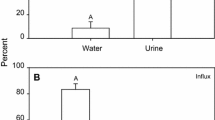Summary
Acute exposure of rainbow trout to hypoxic water (\(Pw_{{\text{O}}_2 }\)=40 mmHg, 15 °C) caused a significant (P<0.01) increase in blood O2 affinity, from the normoxicP 50 value (at pHe 7.93) of 23.2±1.1 mmHg to about 19 mmHg, within 5 min. Specimens injected with the β-antagonist propranolol showed no change in bloodP 50, despite a more pronounced reduction of arterial\(P_{{\text{O}}_2 }\) during the hypoxic exposure.
The change in bloodP 50 coincided with an increase in plasma catecholamines, notably noradrenaline. There was no change in the molar ratios of ATP∶Hb4 and GTP∶Hb4. The altered bloodP 50, however, correlated with an alkalinization and an increased sodium concentration of the red cells. This red cell alkalinization can be explained by β-adrenergic stimulation of a membrane bound Na+/H+ antiporter.
Propranolol injection into normoxic resting trout caused a significant decrease in\(Pa_{{\text{O}}_2 }\) and increase in\(Pa_{{\text{CO}}_2 }\) indicating β-adrenergic control of gas exchange in the gills.
Similar content being viewed by others
References
Baroin A, Garcia-Romeu F, Lamarre T, Motais R (1984) A transient sodium-hydrogen exchange system induced by catecholamines in erythrocytes of rainbow trout,Salmo gairdneri. J Physiol 356:21–31
Borgese F, Garcia-Romeu F, Motais R (1986) Catecholamine-induced transport systems in trout erythrocyte. Na+/H+ countertransport or NaCl cotransport? J Gen Physiol 87:551–566
Butler PJ, Taylor EW, Capra MF, Davison W (1978) The effect of hypoxia on the levels of circulating catecholamines in the dogfishScyliorhinus canicula. J Comp Physiol 127:325–330
Butler PJ, Metcalfe JD, Ginsley SA (1986) Plasma catecholamines in the lesser spotted dogfish and rainbow trout at rest and during different levels of exercise. J Exp Biol 123:409–421
Christensen NJ, Vestergaard P, Sørensen T, Rafaelsen OJ (1980) Cerebrospinal fluid adrenaline and noradrenaline in depressed patients. Acta Psychiatr Scand 61:178–182
Christoforides C, Hedley-Whyte J (1969) Effect of temperature and hemoglobin concentration on solubility of O2 in blood. J Appl Physiol 27:592–596
Cossins AR, Richardson PA (1985) Adrenaline-induced Na+/H+ exchange in trout erythrocytes and its effects upon oxygen-carrying capacity. J Exp Biol 118:229–246
Fievet B, Motais R, Thomas S (1987) Role of adrenergic-dependent H+ release from red cells in acidosis induced by hypoxia in trout. Am J Physiol 252:R269-R275
Funder J, Wieth JO (1966) Chloride and hydrogen ion distribution between human red cells and plasma. Acta Physiol Scand 68:234–245
Garby L, Vuille J-C (1961) The amount of trapped plasma in high speed micro-capillary hematocrit centrifuge. Scan J Clin Lab Invest 13:642
Moran F, Kettel LJ, Cugell DW (1966) Measurement of blood\(P_{{\text{O}}_2 }\) with the microcathode electrode. J Appl Physiol 21:725–728
Nikinmaa M (1982) Effects of adrenaline on red cell volume and concentration gradient of protons across the red cell membrane in the rainbow trout,Salmo gairdneri. Molec Physiol 2:287–297
Nikinmaa M (1983) Adrenergic regulation of haemoglobin oxygen affinity in rainbow trout red cells. J Comp Physiol 152:67–72
Nikinmaa M, Huestis WH (1984) Adrenergic swelling of nucleated erythrocytes: cellular mechanisms in a bird, domestic goose, and two teleosts, striped bass and rainbow trout. J Exp Biol 113:215–224
Nilsson S, Pettersson K (1981) Sympathetic nervous control of blood flow in the gills of the Atlantic cod,Gadus morhua. J Comp Physiol 144:157–163
Pettersson K, Johansen K (1982) Hypoxic vasoconstriction and the effects of adrenaline on gas exchange efficiency in fish gills. J Exp Biol 97:263–272
Peyraud-Waitzenegger M (1979) Simultaneous modifications of ventilation and arterial\(P_{{\text{O}}_2 }\) by catecholamines in the eel,Anguilla anguilla L.: participation of α and β effects. J Comp Physiol 129:343–354
Primmett DRN, Randall DJ, Mazeaud M, Boutilier RG (1986) The role of catecholamines in erythrocyte pH regulation and oxygen transport in rainbow trout (Salmo gairdneri) during exercise. J Exp Biol 122:139–148
Stiles GL, Caron MG, Lefkowitz RJ (1984) β-adrenergic receptors: biochemical mechanisms of physiological regulation. Physiol Rev 64:661–743
Soivio A, Nyholm K, Westman K (1975) A technique for repeated sampling of the blood of individual resting fish. J Exp Biol 62:207–217
Tetens V, Lykkeboe G (1981) Blood respiratory properties of rainbow trout,Salmo gairdneri: responses to hypoxia acclimation and anoxic incubation of blood in vitro. J Comp Physiol 145:117–125
Tetens V, Lykkeboe G (1985) Acute exposure of rainbow trout to mild and deep hypoxia: O2 affinity and O2 capacitance of arterial blood. Respir Physiol 61:221–235
Thomas S, Hughes GM (1982) A study of the effects of hypoxia on acid-base status of rainbow trout blood using an extracorporeal blood circulation. Respir Physiol 49:371–382
Thomas S, Fievet B, Motais R (1986) Effect of deep hypoxia on acid-base balance in trout: role of ion transfer processes. Am J Physiol 250:R319-R327
Tucker VA (1967) Method for oxygen content and dissociation curves on microliter blood samples. J Appl Physiol 23:410–414
Weber R (1982) Intraspecific adaptation of hemoglobin function in fish to oxygen availability. In: Addink ADF, Spronk N (eds) Exogenous and endogenous influences on metabolic and neural control. Pergamon Press, Oxford, pp 87–102
Wood CM (1974) A critical examination of the physical and adrenergic factors affecting blood flow through the gills of the rainbow trout. J Exp Biol 60:241–265
Zijlstra WG, Buursma A, Zwart A (1983) Molar absorptivities of human hemoglobin in the visible spectral range. J Appl Physiol 54:1287–1291
Author information
Authors and Affiliations
Rights and permissions
About this article
Cite this article
Tetens, V., Christensen, N.J. Beta-adrenergic control of blood oxygen affinity in acutely hypoxia exposed rainbow trout. J Comp Physiol B 157, 667–675 (1987). https://doi.org/10.1007/BF00700988
Accepted:
Issue Date:
DOI: https://doi.org/10.1007/BF00700988




